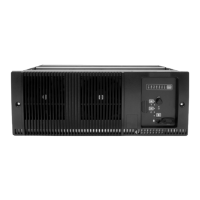12 Description TB9100/P25 CG/P25 TAG Installation and Operation Manual
© Tait Limited March 2014
1.1 Features
The following are some of the features of the base station:
■ Fully compliant with the Project 25 Common Air Interface. Can
therefore interoperate with any similarly compliant radios.
■ Dual mode. Comprehensive analog and digital features ensure
interoperability with analog or digital technology. The base station can
switch seamlessly between analog FM and digital P25 communications
on a per-call basis.
■ Integrated built-in voting facility. No external voter is needed.
■ Can be completely managed remotely from a PC running the Tait
Customer Service Software (CSS): configuration, alarm monitoring,
fault diagnosis, feature and firmware upgrades.
■ An integrated wiring solution is provided for the system control bus and
DC power connections to each reciter.
■ Reciters can be replaced without affecting the operation of other reciters
in the same subrack.
■ Rugged construction with generous heatsinks and fan-forced cooling for
continuous operation from –30°C to +60°C (–22°F to +140°F).
The following are some of the features of the gateways:
■ Project 25 standard DES or AES encryption and decryption at the analog
line interface.
■ Support for MDC1200, E&M, and function tone signaling on the analog
line.
1.2 Base Station and Gateway
Like the base station, the console gateway and trunked analog gateway can
be unpacked, given an IP address, set up on the bench, and used with a
Calibration and Test Unit (CTU). AC and DC power, the analog line, and
Ethernet are connected up in the same way for both a base station and a
gateway. The gateway has a front panel with fans and a control panel. It can
also be monitored and configured by the CSS, much as a base station.
Although the gateway module has an RF board (as well as a digital board
and a network board), that board has only limited functionality, such as
providing clock signals. The gateway subrack can be populated with
multiple gateway modules, in the same way that the base station can be
populated with multiple reciters. A faulty gateway module or power
management unit (PMU) is replaced in the same way.
The control panel in a console gateway operates as for a base station, except
that the Carrier button has no effect and the microphone can only transmit
via the connected channel group. The speaker can output the channel
group’s vote winner (if unencrypted), but the console gateway cannot itself
provide any receive audio, as it has no RF capability. The control panel in a

